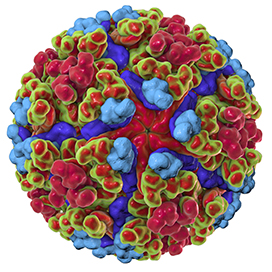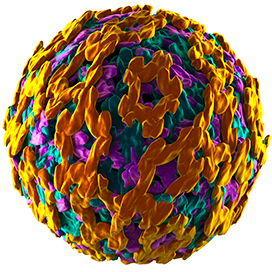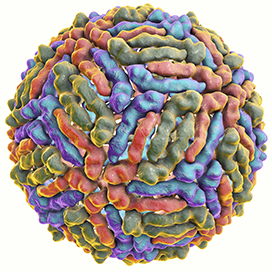The World Reference Center for Emerging Viruses
and Arboviruses
The World Reference Center for Emerging Viruses and Arboviruses (WRCEVA) at the University of Texas Medical Branch (UTMB) serves as a virus reference center for the world.

Any virus suspected of being biologically transmitted by arthropods or vertebrates is accepted for identification and characterization. The current WRCEVA virus collection consists of over 8,000 unique virus strains. In addition to most of the arthropod-transmitted viruses, a number of bat- and rodent-associated viruses (i.e. hantaviruses, paramyxoviruses, arenaviruses, filoviruses, picornaviruses) together with their respective antigens and antisera are also included in the reference collection. Many of the latter viruses were initially isolated from clinical samples taken from patients with suspected arboviral infections, such as dengue hemorrhagic fever or yellow fever, or from wild vertebrates collected during epidemiologic field studies.
The WRCEVA is a direct outgrowth of the worldwide network of laboratories established by the Rockefeller Foundation about 60 years ago to study the role of arthropod-borne viruses in producing human and animal disease and the mechanisms by which these viruses were maintained and transmitted in nature.

When this program was initiated at the Rockefeller Foundation Virus Laboratories in New York City in 1951, fewer than 28 arboviruses had been described; and only a few, such as yellow fever, the mosquito-borne encephalitides, and dengue were known to cause serious disease in human beings.
Concurrent with the initiation of the Rockefeller Foundation program, the U.S. Army, U.S. Navy, U.S. Public Health Services and several foreign governments also established arbovirus laboratories and field research programs. This network of field laboratories relied on the Foundation’s central virus reference laboratory in New York until 1964, when the central laboratory and some of the Rockefeller staff were moved to Yale University where the service was continued until 1995.
In 1995, Drs. Robert Tesh and Robert Shope moved from Yale to the Center for Tropical Diseases (now renamed Center for Biodefense and Emerging Infectious Diseases) at UTMB in Galveston and brought the reference collection with them. The decision to establish the Reference Center at UTMB was based in part on the willingness of the University to provide modern state-of the art laboratory equipment and space, with appropriate BSL-3 and BSL-4 containment facilities for working with select and other hazardous agents.
The WRCEVA provides prompt analysis of disease outbreaks as well as identification of new and emerging viruses to agencies around the world; it also serves the world research community with basic certification and distribution of zoonotic viruses and viral reagents.

The extensive virus collection maintained at the WRCEVA differs from repository collections like that of the American Type Culture Collection in several ways. First, the collection is not static; new virus strains are continually being archived. Second, instead of having just one or two prototype or well characterized strains of each virus, the WRCEVA virus collection has many different strains of arboviruses of medical and veterinary importance (i.e. dengue, yellow fever, Japanese encephalitis, West Nile, eastern equine encephalitis, and Venezuelan equine encephalitis). A number of viruses in the collection are select agents. An effort has been made to collect representative strains of these viruses from a variety of hosts, geographic localities and time periods. This diversity has proven extremely useful in studies of virus emergence, evolution, taxonomy, pathogenesis, vaccine efficacy and biodefense. Third, all work (preparation of virus stocks, antigens, antisera, viral RNA or DNA) is done on site, as UTMB has the required containment facilities to work safely with highly pathogenic and/or select agents under BSL-3 and BSL-4 laboratory conditions and it has USDA-approved facilities for experimental infection of laboratory animals with these agents. This reduces costs, since the work does not have to be contracted out; and it reduces turn-around time and response to requests for reagents.
Our ability to supply viruses and viral reagents without charge is also a valuable service to the virology community at large, since relatively few of these items are available commercially. Current biosafety regulations governing work with infectious agents and vertebrate animals now require that a high level of containment (BSL-3 or BSL-4) be used when handling many zoonotic viral pathogens. In addition, concerns about bioterrorism and security have further restricted the transfer and exchange of some infectious (select) agents between investigators. Consequently, just the production of viral RNA or an immune serum to some viruses has become extremely expensive or impossible for researchers and diagnostic laboratories that do not have access to approved biocontainment facilities. The WRCEVA is often able to fill this need by preparing and supplying some of these reagents.
Training is another important part of the Reference Center’s activities. In addition to UTMB graduate students and fellows, a number of visiting scientists each year spend time in the Reference Center, learning classical virologic techniques as well as newer molecular methods for virus assay and identification. Members of the Reference Center staff also participate in workshops and conferences on arbovirus techniques and arboviral diseases.
Since 1971, the World Reference Center has been supported by grants and contracts from the National Institutes of Health. Since 1995, the University of Texas has also provided extensive in-house support to the Reference Center. Dr. Scott Weaver, Professor of Pathology and a member of the Center for Biodefense and Emerging Infectious Diseases (CBEID), is the current director of the WRCEVA. Dr. Thomas G. Ksiazek, Professor of Pathology and formerly head of the Special Pathogens Branch, CDC/Atlanta, is the Deputy Director.
